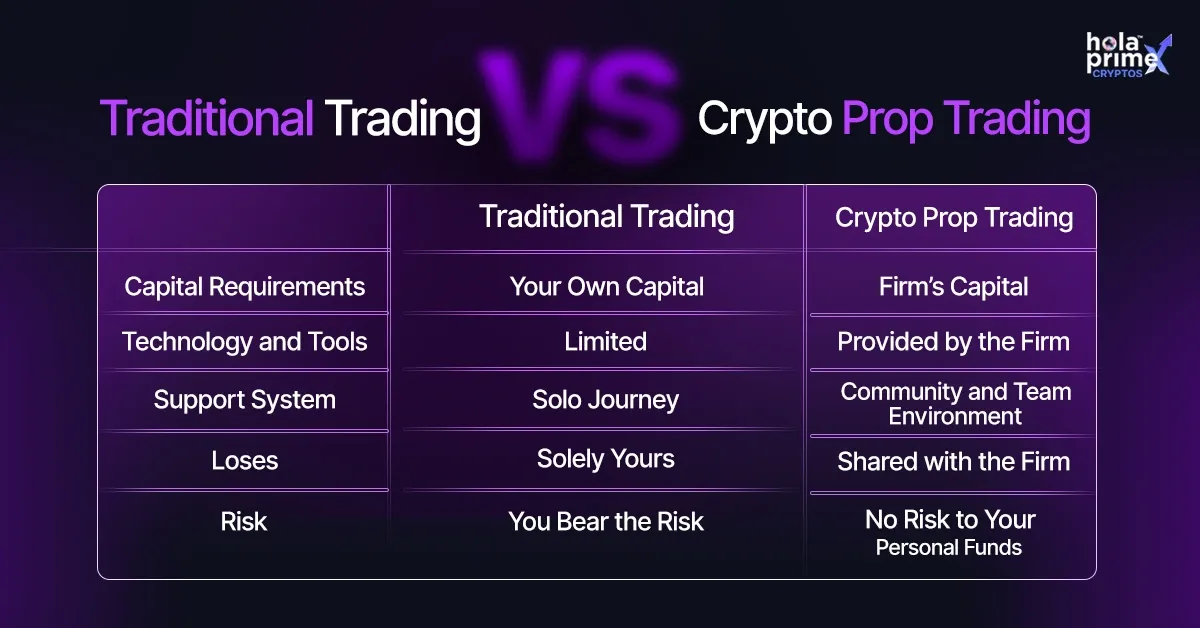
The trading world is evolving fast, and two paths stand out: crypto prop trading and traditional trading. In traditional trading, you have to trade with your own funds, meaning the risk is all yours. However, in crypto prop trading, you trade with funds offered by the firm. Since crypto is highly volatile, the risk stays with the firm. Whether you’re a risk-taker or a steady strategist, knowing how these approaches differ can help you make smarter, more aligned trading decisions.Completing a crypto prop challenge can be your gateway to trading with substantial capital. But it is not as simple as it sounds. These firms will test your discipline, risk management, and strategy execution. So, you will need to be aware of how the challenge is structured and be compliant with the challenge as you trade consistently. The cryptocurrency market is ever-changing and provides rich opportunities while also carrying risk. As a proprietary trader, you are given the prop firm’s account to trade with, and your goal is to achieve sizable returns within defined risk boundaries. To be profitable, you can’t simply rely on gut feeling; you need an understanding of the market.
In this blog, we will cover advanced crypto trading strategies: momentum trading, mean reversion, triangular arbitrage, and diversification tailored specifically for prop traders.
Crypto prop trading is where an individual trades cryptocurrencies using a firm’s capital instead of their own. These traders pass evaluations to access simulated funded accounts and earn rewards while minimizing personal risks in a highly volatile market.
Traders allocate their own capital to very liquid financial instruments like forex and commodities, wherever they see fit to open and close positions. Traders may also use brokers, statistical methods, basic patterns, and a mixture of fundamental and technical analysis whilst trading standardized markets during market hours and rules they know in advance.

In crypto prop trading, traders typically don’t need to risk their own capital. Instead, they may pass a challenge or pay a small fee to qualify for access to a simulated funded account with significant buying power, minimizing personal financial exposure.
Traditional trading requires personal capital from the outset. Traders must use their own funds and often meet brokerage margin requirements. This means higher personal financial risk, but also full control over the capital and decisions.
Crypto prop trading is driven by modern technologies, automated strategies, AI-based analytics, dashboards, and decentralized exchange accessibility. Many crypto prop firms, such as Hola Prime X, utilize performance-driven systems due to the possibility of attracting technologically savvy traders who appreciate speed and innovation. Prop firms provide these tools and resources for free.
Traditional trading platforms are secure and reliable; however, they are typically built on outdated platforms. In traditional trading, reliability, compliance, and institutional access are prioritized over continuous innovation. Traders must pay and conduct their own research to gain access to advanced tools and resources.
Traders with access to crypto prop firms often work within a team environment, with access to coaching, communities, and mentorship. This structure supports faster growth and accountability, which is especially valuable for those still refining their edge or strategy.
Most traditional traders are solo traders learning through trial and error. There are online communities, but support is typically unstructured. The process is often self-guided and can take a high degree of self-discipline, self-education, and self-motivation.
In crypto prop trading, the losses are shared with the firm and limited by rules. This allows traders to stay focused on performance without risking personal capital or facing severe financial setbacks after one or two poor trades.
In traditional trading, however, all losses are borne by the trader. Mistakes or misjudged trades directly impact personal funds. Emotional decisions can lead to larger drawdowns, making risk management in traditional trading critical from the start.
When it comes to crypto prop trading, there’s no financial exposure to your own funds. The firm provides capital, and traders operate within strict limits and rules. This reduces emotional pressure and enables focused, performance-driven trading in a safer environment.
With traditional trading, you trade using your own capital, accepting full responsibility for profits and losses. High personal risk increases emotional stress and demands strong discipline, risk management, and experience to avoid severe drawdowns or account wipeouts.
Having learned about both, you know very well where you stand as a trader. If you are someone who prefers and thrives on speed and flexibility, then crypto prop trading might be your thing. Whereas, if you prefer stability, regulations, and established systems, then traditional trading is more your style. Take the time to understand and weigh in on the differences to choose a path that best aligns with your skills and financial aspirations.
Yes. Because in crypto prop trading, you trade with the firm’s funds, but in traditional trading, you have to risk your own capital.
No. Crypto markets are open around the clock, while some traditional markets only trade for set hours and even close for the weekend and holidays.
Yes. Leading firms, like Hola Prime X, provide education through webinars, tutorials, research tools, and mentorship as ways to help traders refine and develop their skills and strategies.
Even though crypto focuses only on digital assets, traditional trading has many more options since it represents forex, indices, and commodities.
Yes, many prop firms like Hola Prime X allow crypto trading.
Disclaimer: All information provided on this site is for educational purposes only, related to trading in financial markets. It is not intended as financial advice, business or investment recommendation, or as an opportunity or recommendation to trade any investment instruments. Hola Prime only provides an educational environment to traders, including tools, materials and simulated trading platforms which have data feed provided by Liquidity Providers. The information on this site is not directed at residents in any country or jurisdiction where such distribution or use would be contrary to local laws or regulations.
The only prop firm with
1-HOUR PAYOUT.
Get Started for just
$37